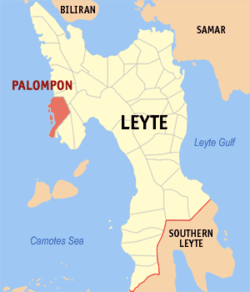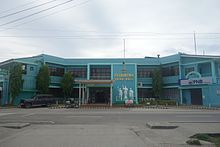Palompon
Palompon | |
|---|---|
| Municipality of Palompon | |
 | |
 Map of Leyte with Palompon highlighted | |
Location within the Philippines | |
| Coordinates: 11°03′N 124°23′E / 11.05°N 124.38°E | |
| Country | Philippines |
| Region | Eastern Visayas |
| Province | Leyte |
| District | 4th district |
| Founded | 1620 |
| Barangays | 50 (see Barangays) |
| Government | |
| • Type | Sangguniang Bayan |
| • Mayor | Myr. Ramon C. Oñate |
| • Vice Mayor | Ferdinand Dela Calzada |
| • Representative | Richard Gomez |
| • Councilors | List |
| • Electorate | 43,065 voters (2022) |
| Area | |
• Total | 126.07 km2 (48.68 sq mi) |
| Elevation | 4.9 m (16.1 ft) |
| Highest elevation | 535 m (1,755 ft) |
| Lowest elevation | 0 m (0 ft) |
| Population (2020 census)[4] | |
• Total | 58,313 |
| • Density | 460/km2 (1,200/sq mi) |
| • Households | 14,969 |
| Demonym | Palomponganon |
| Economy | |
| • Income class | 2nd municipal income class |
| • Poverty incidence | 25.90 |
| • Revenue | ₱ 299 million (2020), 96.79 million (2012), 106.5 million (2013), 123 million (2014), 172.2 million (2015), 178.5 million (2016), 196.2 million (2017), 206.7 million (2018), 241.6 million (2019), 228.9 million (2021), 300 million (2022) |
| • Assets | ₱ 756.4 million (2020), 192.9 million (2012), 216.2 million (2013), 248.6 million (2014), 393 million (2015), 477.4 million (2016), 572.8 million (2017), 599.9 million (2018), 718.7 million (2019), 822.2 million (2021), 925.4 million (2022) |
| • Expenditure | ₱ 260.4 million (2020), 154.1 million (2012), 98.35 million (2013), 104.9 million (2014), 142.9 million (2015), 138 million (2016), 169.8 million (2017), 181.7 million (2018), 190.4 million (2019), 173.2 million (2021), 193.5 million (2022) |
| • Liabilities | ₱ 223.1 million (2020), 89.49 million (2012), 120.6 million (2013), 134 million (2014), 202.8 million (2015), 230.4 million (2016), 253.4 million (2017), 226.5 million (2018), 234.3 million (2019), 219.8 million (2021), 223.6 million (2022) |
| Service provider | |
| • Electricity | Leyte 5 Electric Cooperative (LEYECO 5) |
| Time zone | UTC+8 (PST) |
| ZIP code | 6538 |
| PSGC | |
| IDD : area code | +63 (0)53 |
| Native languages | Cebuano |
Palompon (IPA: [pɐ'lompɔn]), officially the Municipality of Palompon (Cebuano: Lungsod sa Palompon; Waray: Bungto han Palompon; Tagalog: Bayan ng Palompon), is a 2nd class municipality in the province of Leyte, Philippines. According to the 2020 census, it has a population of 58,313 people.[4]
History
[edit]
Along the strip of the fertile coast, the community was founded circa 1620 and originally named Hinablayan. Fish, sea shells, and other marine products abounded. People fished along the shore with arrows tied to vines. Its abundance attracted not only migrants but also Moro raiders from the south. Legend tells that local defenders used to hang the dead bodies of Moros on tree branches so that the place come to be known as Hinablayan (from the word sablay which means "to hang").[6]
The legend continues that when the Spaniards came they saw floating at the bay a cluster (pong pong) of mangrove propagules locally known as "Tungki", they decided to change the name of Hinablayan to Paungpung, after the cluster of mangrove propagules to erase the bloody memory of the Moro raiders. Gradually the name evolved to Palompong, then to Palumpun, and its current spelling of Palompon sometime in 1700 or 1800. It is said that cluster later got stuck to the shoal until they grew up as trees, forming an islet which is Tabuk Island today.[6]
In 1737, Jesuit missionaries arrived and built the first chapel which was later burned during a Moro raid. It was rebuilt and, as a refuge from attack, the chapel was enclosed with piled stones, with a "cota" along the frontage. When the people saw Moro vintas coming, the big church bell would ring the alarm and people rushed inside the church, fighting back with bows and arrows and spears.[6]
The place assumed the role of cabeceria of all the municipalities in the north-western side of Leyte during the Spanish regime. At that time Palompon was under the parish of Hilongos. The parish priest visited the place occasionally for marriage, baptism and masses.
The Jesuits, later succeeded by the Augustinians, built the present church with 300 natives, who were forced labor without pay. If one or some of the laborers were unable to work, they were substituted by others just to maintain the quota every day for the next thirty years. The structure soon became a landmark of Palompon, reputed to be the oldest church in Leyte. On November 12, 1784, Palompon obtained its parochial independence from Hilongos.[6]
Sometime in late 17th century, there was a nine-day battle between the Palomponganons and Moro raiders during which the residents rushed to the stone church (newly completed at that time) and took refuge for more than a week. The Moros suffered losses in that encounter and were defeated. A cannon in the town's plaza is a relic of that battle.[7]
Ormoc remained part of Palompon parish from 1784 until 1851, when finally it was declared as an independent parish. Villaba and Matag-ob were both part of the territorial jurisdiction of this town as well before they obtained their municipio (pueblo) status.
In 1957 the barrios of Santo Rosario, Santa Rosa, Balagtas, San Vicente and Mabini were separated from the municipality of Palompon and constituted into Matag-ob.[8]
Geography
[edit]Climate
[edit]| Climate data for Palompon, Leyte | |||||||||||||
|---|---|---|---|---|---|---|---|---|---|---|---|---|---|
| Month | Jan | Feb | Mar | Apr | May | Jun | Jul | Aug | Sep | Oct | Nov | Dec | Year |
| Mean daily maximum °C (°F) | 28 (82) |
29 (84) |
29 (84) |
30 (86) |
30 (86) |
30 (86) |
29 (84) |
29 (84) |
29 (84) |
29 (84) |
29 (84) |
29 (84) |
29 (84) |
| Mean daily minimum °C (°F) | 22 (72) |
22 (72) |
22 (72) |
23 (73) |
25 (77) |
25 (77) |
25 (77) |
25 (77) |
25 (77) |
24 (75) |
24 (75) |
23 (73) |
24 (75) |
| Average precipitation mm (inches) | 78 (3.1) |
57 (2.2) |
84 (3.3) |
79 (3.1) |
118 (4.6) |
181 (7.1) |
178 (7.0) |
169 (6.7) |
172 (6.8) |
180 (7.1) |
174 (6.9) |
128 (5.0) |
1,598 (62.9) |
| Average rainy days | 16.7 | 13.8 | 17.3 | 18.5 | 23.2 | 26.5 | 27.1 | 26.0 | 26.4 | 27.5 | 24.6 | 21.0 | 268.6 |
| Source: Meteoblue[9] | |||||||||||||
Barangays
[edit]
Palompon is politically subdivided into 50 barangays, [10] Each barangay consists of puroks and some have sitios.
- Baguinbin
- Belen
- Bitaog Poblacion (Ypil III)
- Buenavista
- Caduhaan
- Cambakbak
- Cambinoy
- Cangcosme
- Cangmuya
- Canipaan
- Cantandoy
- Cantuhaon
- Catigahan
- Central 1 (Poblacion)
- Central 2 (Poblacion)
- Cruz
- Duljugan
- Guiwan 1 (Poblacion)
- Guiwan 2 (Poblacion)
- Himarco
- Hinablayan Poblacion (Central 3)
- Hinagbuan
- Lat-osan
- Liberty
- Lomonon
- Mabini
- Magsaysay
- Masaba
- Mazawalo Poblacion (Lili-on)
- Parilla
- Pinagdait Poblacion (Ypil I)
- Pinaghi-usa Poblacion (Ypil II)
- Plaridel
- Rizal
- Sabang
- San Guillermo
- San Isidro
- San Joaquin
- San Juan
- San Miguel
- San Pablo
- San Pedro
- San Roque
- Santiago
- Taberna
- Tabunok
- Tambis
- Tinabilan
- Tinago
- Tinubdan
10 of which are poblacion barangays with an area of approximately 1 square kilometer; the other forty 40 barangays are distributed along the coastline and in the interior rural and mountainous areas.
Demographics
[edit]
|
| |||||||||||||||||||||||||||||||||||||||||||||||||||
| Source: Philippine Statistics Authority [11][12][13][14] | ||||||||||||||||||||||||||||||||||||||||||||||||||||
In the 2020 census, the population of Palompon, Leyte, was 58,313 people,[4] with a density of 460 inhabitants per square kilometre or 1,200 inhabitants per square mile.
Language
[edit]Cebuano (Kana dialect) is widely spoken in Palompon. Waray-Waray may also be spoken by students from neighboring areas with native Waray-Waray speakers.
Economy
[edit]Poverty incidence of Palompon
10
20
30
40
2006
30.10 2009
30.31 2012
27.73 2015
28.80 2018
20.82 2021
25.90 Source: Philippine Statistics Authority[15][16][17][18][19][20][21][22] |
Education
[edit]Palompon has 2 tertiary institutions:
- Palompon Institute of Technology
- Northern Leyte College
It also has 12 secondary institutions:
Public
[edit]- Palompon National Highschool
- Lomonon National Highschool
- Tinabilan National Highschool
- Alfredo Parilla National Highschool (San Miguel)
- Taberna National Highschool
- Cantuhaon National Highschool
- San Guillermo National Highschool
Private
[edit]- PIT Laboratory Highschool (Semi-Public)
- Colegio de San Francisco Javier
- NLC Laboratory Highschool
- Ace Learning Center Inc.
- PromisedLand Educational Academy Inc.
References
[edit]- ^ Municipality of Palompon | (DILG)
- ^ "2015 Census of Population, Report No. 3 – Population, Land Area, and Population Density" (PDF). Philippine Statistics Authority. Quezon City, Philippines. August 2016. ISSN 0117-1453. Archived (PDF) from the original on May 25, 2021. Retrieved July 16, 2021.
- ^ https://www.philatlas.com/visayas/r08/leyte/palompon.html.
{{cite web}}: Missing or empty|title=(help) - ^ a b c Census of Population (2020). "Region VIII (Eastern Visayas)". Total Population by Province, City, Municipality and Barangay. Philippine Statistics Authority. Retrieved 8 July 2021.
- ^ "PSA Releases the 2021 City and Municipal Level Poverty Estimates". Philippine Statistics Authority. 2 April 2024. Retrieved 28 April 2024.
- ^ a b c d Arcadio A. Molon, Jr. (2013). "History". Palompon Municipality. Archived from the original on 23 July 2013. Retrieved 17 June 2013.
- ^ Manuel Artigas de Cuerva “Resena de la Historia de la Provincia de Leyte”
- ^ "An Act Creating the Municipality of Matag-ob in the Province of Leyte". LawPH.com. Archived from the original on 2012-07-13. Retrieved 2011-04-12.
- ^ "Palompon: Average Temperatures and Rainfall". Meteoblue. Retrieved 29 February 2020.
- ^ "Province:". PSGC Interactive. Quezon City, Philippines: Philippine Statistics Authority. Retrieved 12 November 2016.
- ^ Census of Population (2015). "Region VIII (Eastern Visayas)". Total Population by Province, City, Municipality and Barangay. Philippine Statistics Authority. Retrieved 20 June 2016.
- ^ Census of Population and Housing (2010). "Region VIII (Eastern Visayas)" (PDF). Total Population by Province, City, Municipality and Barangay. National Statistics Office. Retrieved 29 June 2016.
- ^ Censuses of Population (1903–2007). "Region VIII (Eastern Visayas)". Table 1. Population Enumerated in Various Censuses by Province/Highly Urbanized City: 1903 to 2007. National Statistics Office.
- ^ "Province of". Municipality Population Data. Local Water Utilities Administration Research Division. Retrieved 17 December 2016.
- ^ "Poverty incidence (PI):". Philippine Statistics Authority. Retrieved December 28, 2020.
- ^ "Estimation of Local Poverty in the Philippines" (PDF). Philippine Statistics Authority. 29 November 2005.
- ^ "2003 City and Municipal Level Poverty Estimates" (PDF). Philippine Statistics Authority. 23 March 2009.
- ^ "City and Municipal Level Poverty Estimates; 2006 and 2009" (PDF). Philippine Statistics Authority. 3 August 2012.
- ^ "2012 Municipal and City Level Poverty Estimates" (PDF). Philippine Statistics Authority. 31 May 2016.
- ^ "Municipal and City Level Small Area Poverty Estimates; 2009, 2012 and 2015". Philippine Statistics Authority. 10 July 2019.
- ^ "PSA Releases the 2018 Municipal and City Level Poverty Estimates". Philippine Statistics Authority. 15 December 2021. Retrieved 22 January 2022.
- ^ "PSA Releases the 2021 City and Municipal Level Poverty Estimates". Philippine Statistics Authority. 2 April 2024. Retrieved 28 April 2024.



